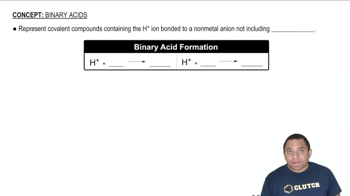Ch.23 - Organic and Biological Chemistry
Chapter 23, Problem 89
Show the structure of glyceryl trioleate, a fat molecule composed of glycerol and three oleic acid units.
 Verified step by step guidance
Verified step by step guidance1
Step 1: Understand the components of glyceryl trioleate. It is composed of a glycerol backbone and three oleic acid molecules.
Step 2: Draw the glycerol backbone. Glycerol is a three-carbon molecule with hydroxyl (OH) groups attached to each carbon: HO-CH2-CH(OH)-CH2-OH.
Step 3: Recognize the structure of oleic acid. Oleic acid is a monounsaturated fatty acid with the formula C18H34O2, featuring a cis double bond between the 9th and 10th carbon atoms.
Step 4: Attach each oleic acid to the glycerol backbone via esterification. This involves forming an ester bond between the hydroxyl group of glycerol and the carboxyl group of oleic acid, releasing water (H2O) in the process.
Step 5: Illustrate the complete structure of glyceryl trioleate. The glycerol backbone is now linked to three oleic acid chains through ester bonds, forming a triester, which is a common structure for fats and oils.
Key Concepts
Here are the essential concepts you must grasp in order to answer the question correctly.
Glycerol Structure
Glycerol is a simple polyol compound with three hydroxyl (-OH) groups, making it a trihydroxy alcohol. Its structure consists of a three-carbon chain, where each carbon is bonded to a hydroxyl group. This unique structure allows glycerol to act as a backbone for triglycerides, facilitating the formation of ester bonds with fatty acids.
Recommended video:
Guided course

Resonance Structures
Fatty Acids
Fatty acids are long hydrocarbon chains with a carboxylic acid group (-COOH) at one end. They can be saturated or unsaturated, depending on the presence of double bonds between carbon atoms. Oleic acid, specifically, is a monounsaturated fatty acid with one double bond, which influences the physical properties of fats, such as melting point and fluidity.
Recommended video:
Guided course

Binary Acids
Triglyceride Formation
Triglycerides are formed through a condensation reaction between glycerol and three fatty acid molecules, resulting in the release of water. Each fatty acid forms an ester bond with one of the hydroxyl groups of glycerol, creating a fat molecule. Glyceryl trioleate, specifically, consists of glycerol esterified with three oleic acid units, making it a common dietary fat.
Recommended video:
Guided course

Enthalpy of Formation
Related Practice
